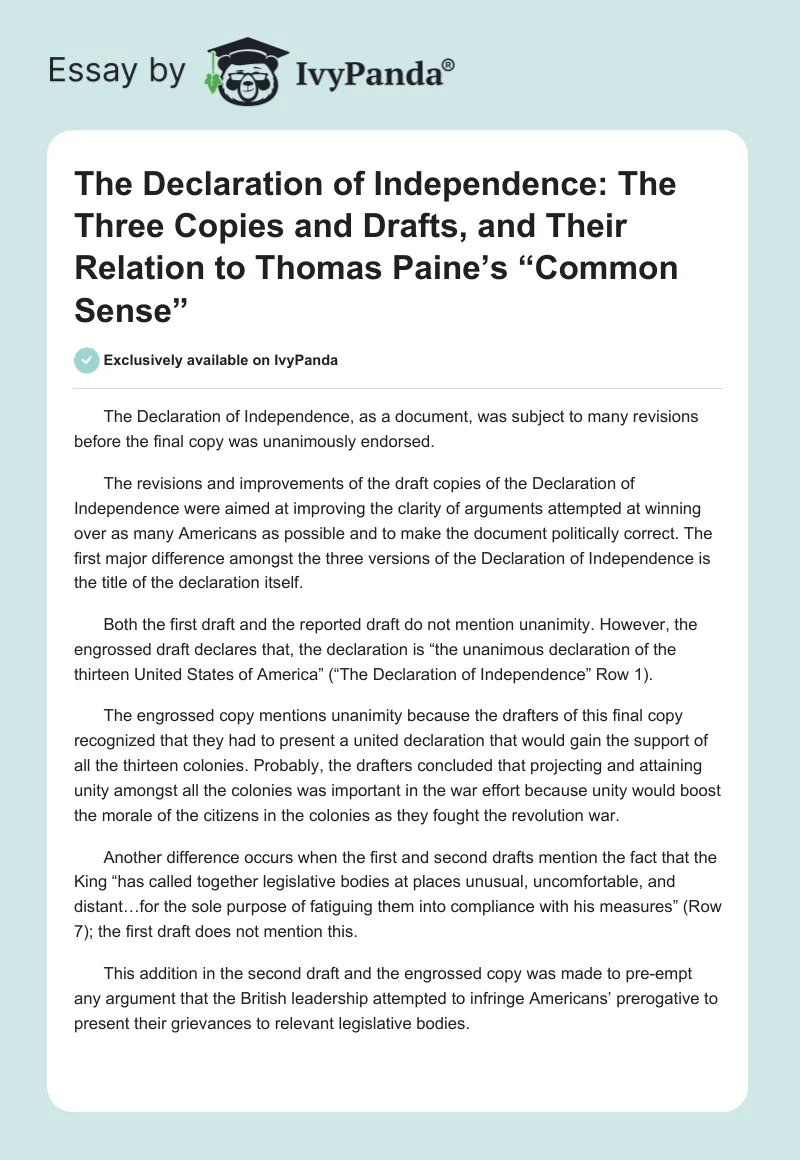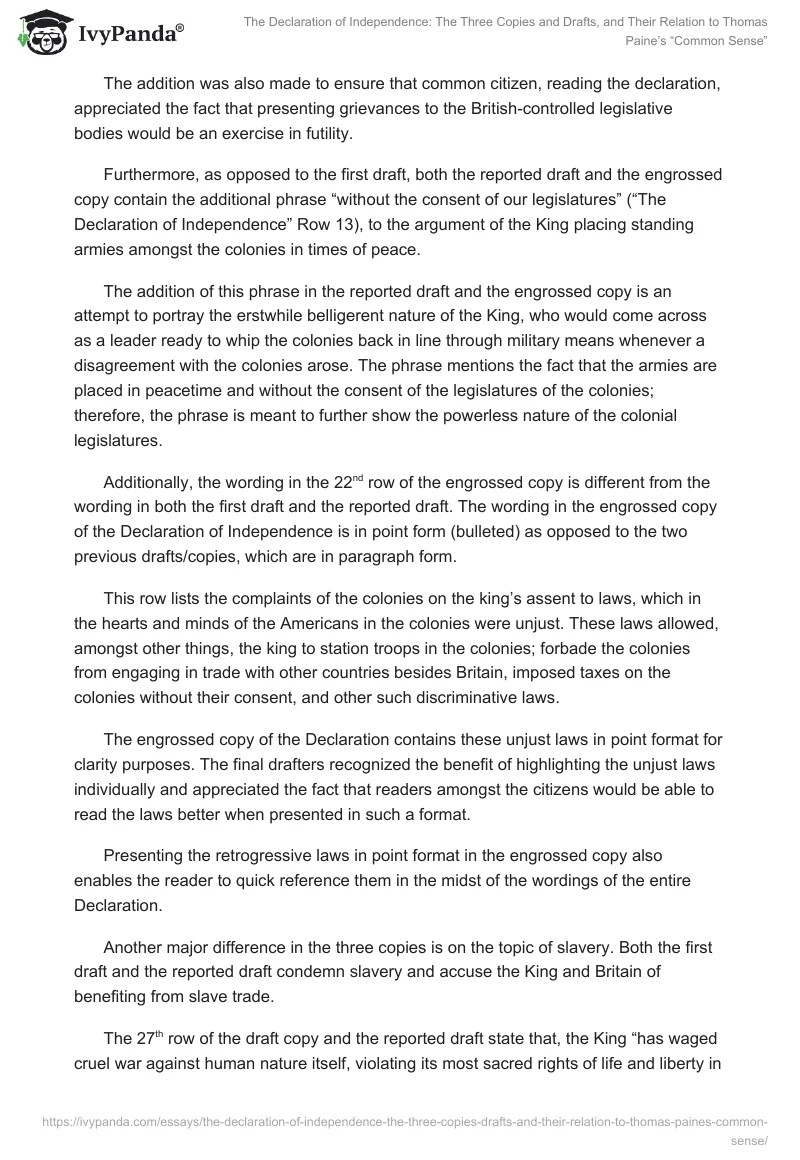The Declaration of Independence, as a document, was subject to many revisions before the final copy was unanimously endorsed.
The revisions and improvements of the draft copies of the Declaration of Independence were aimed at improving the clarity of arguments attempted at winning over as many Americans as possible and to make the document politically correct. The first major difference amongst the three versions of the Declaration of Independence is the title of the declaration itself.
Both the first draft and the reported draft do not mention unanimity. However, the engrossed draft declares that, the declaration is “the unanimous declaration of the thirteen United States of America” (“The Declaration of Independence” Row 1).
The engrossed copy mentions unanimity because the drafters of this final copy recognized that they had to present a united declaration that would gain the support of all the thirteen colonies. Probably, the drafters concluded that projecting and attaining unity amongst all the colonies was important in the war effort because unity would boost the morale of the citizens in the colonies as they fought the revolution war.
Another difference occurs when the first and second drafts mention the fact that the King “has called together legislative bodies at places unusual, uncomfortable, and distant…for the sole purpose of fatiguing them into compliance with his measures” (Row 7); the first draft does not mention this.
This addition in the second draft and the engrossed copy was made to pre-empt any argument that the British leadership attempted to infringe Americans’ prerogative to present their grievances to relevant legislative bodies.
The addition was also made to ensure that common citizen, reading the declaration, appreciated the fact that presenting grievances to the British-controlled legislative bodies would be an exercise in futility.
Furthermore, as opposed to the first draft, both the reported draft and the engrossed copy contain the additional phrase “without the consent of our legislatures” (“The Declaration of Independence” Row 13), to the argument of the King placing standing armies amongst the colonies in times of peace.
The addition of this phrase in the reported draft and the engrossed copy is an attempt to portray the erstwhile belligerent nature of the King, who would come across as a leader ready to whip the colonies back in line through military means whenever a disagreement with the colonies arose. The phrase mentions the fact that the armies are placed in peacetime and without the consent of the legislatures of the colonies; therefore, the phrase is meant to further show the powerless nature of the colonial legislatures.
Additionally, the wording in the 22nd row of the engrossed copy is different from the wording in both the first draft and the reported draft. The wording in the engrossed copy of the Declaration of Independence is in point form (bulleted) as opposed to the two previous drafts/copies, which are in paragraph form.
This row lists the complaints of the colonies on the king’s assent to laws, which in the hearts and minds of the Americans in the colonies were unjust. These laws allowed, amongst other things, the king to station troops in the colonies; forbade the colonies from engaging in trade with other countries besides Britain, imposed taxes on the colonies without their consent, and other such discriminative laws.
The engrossed copy of the Declaration contains these unjust laws in point format for clarity purposes. The final drafters recognized the benefit of highlighting the unjust laws individually and appreciated the fact that readers amongst the citizens would be able to read the laws better when presented in such a format.
Presenting the retrogressive laws in point format in the engrossed copy also enables the reader to quick reference them in the midst of the wordings of the entire Declaration.
Another major difference in the three copies is on the topic of slavery. Both the first draft and the reported draft condemn slavery and accuse the King and Britain of benefiting from slave trade.
The 27th row of the draft copy and the reported draft state that, the King “has waged cruel war against human nature itself, violating its most sacred rights of life and liberty in the persons of distant people, who never offended him, captivating and carrying them into slavery in another hemisphere, or to incur miserable death in their transportation thither” (“The Declaration of Independence”).
The engrossed copy however makes no mention of slavery; actually, the paragraph condemning it in the first two drafts/copies is conspicuously missing in this copy. The removal of the clause on slavery was a matter of practicability; moreover, it pricked the consciences of the drafters.
Many of the drafters owned slaves and therefore, to blame the King for not stopping slave trade would have been hypocritical. The fact the drafters were fighting for their freedom and yet slavery was prevalent in the American colonies would have been tough to explain and defend amongst the masses.
The Declaration of Independence relates to Thomas Paine’s “Common Sense” because both were published in 1776, and both called for the severing of political and socio-economic ties with Britain. Both the Declaration of Independence and Thomas Paine’s “Common Sense” argue that, Britain will hinder the commercial rise of America by limiting its trade partners through retrogressive laws (“Common sense”, Para. 35).
Both documents also explain the fact that Britain was only interested in its rise and did not care for the interest of its colonies worldwide, including the American colonies.
Works Cited
Paine, Thomas. Common Sense. Philadelphia: W and T. Bradford, 1776. Web.
“The Declaration of Independence”. The Want, Will, and Hopes of People, 1995. Web.


